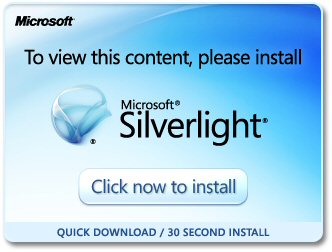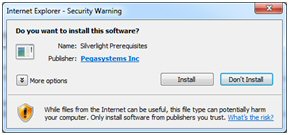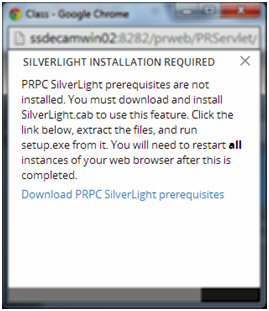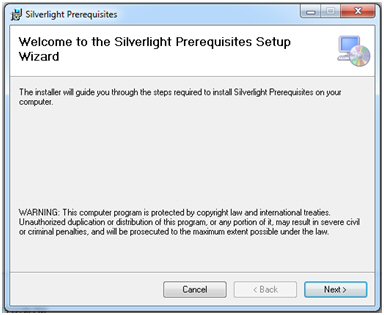Word merge support with Microsoft Silverlight plug-in
Valid from Pega Version 7.1.3
PRPC features that integrate with the Word merge capability are now cross-browser. ActiveX controls (which are only compatible with IE) have been replaced with Microsoft Silverlight. This plug-in must be downloaded separately from Microsoft, as it is not shipped with PRPC.
Some common PRPC features affected by this change include the Application Document Wizard, App Profile, Specifications Landing Page, Specification form, and Case Type Landing Page.
Prior to using these features, Users of PRPC 7.1.3 need to set up their client system(s) as follows:
1. Install Silverlight plug-in
Follow the PRPC prompt to install Silverlight when you attempt to use the Word merge feature:

Or download package directly: www.microsoft.com/silverlight/
2. Install PRPC prerequisites
Microsoft Internet Explorer (IE) browsers automatically detect the need for PRPC prerequisites and will prompt for install:

Non-IE browsers will load a pop-up window when the user attempts to use the Word merge feature. Use the link to manually download PRPC prerequisites:

Extract the .zip file, execute setup.exe and follow the install wizard:

Administrators setting up multiple clients at once may refer to the pzSLpreReqs.cab available in the PRPC 7.1.3 resource kit.
3. Restart browser
Log out of PRPC, close all open sessions and restart your browser.
The PRPC feature integrated with Word merge is now ready for use; Silverlight prompts are no longer displayed.
4. Troubleshooting
Silverlight installation requires access to your file system and a registry setting update to “trust” the associated Verisign certificate. Contact your administrator if you encounter any security or permission errors during this process.
See the PRPC Developer Help for more information on browser setup requirements.
Data Management
Valid from Pega Version 7.1.3
Improvements to data handling were made for the Data Pages, autopopulate properties, and reference properties. Lightweight lists were optimized.
- Property references are now maintained on the Work Page.
- PageList properties can reference a Data Page.
- Auto-populate properties can be used in a seciton to show results from a Data Page.
- Data Pages can run in “Page” mode as well as “List” mode
- The "Rules Not Using Lightweight List" report was enhanced.
- A PageList property that references a Data Page may be used to populate a grid.
- Related autopopulated properties can now be referenced.
Integration
Valid from Pega Version 7.1.3
Usability enhancements have been made to the integration wizards. The REST end-point integration has been improved, and XML parsing functionality has been enhanced.
- PRPC services can return Report or Listview data as XML.
- Work items may now be processed when accessing from a link in system-created emails.
- An SMTP outage will not cause an application to stop working.
- File listener will now read files using a leading asterisk (*).
- XML Parse rule will handle schema validation.
- PegaImageViewer will now work with Version 7.1.
- Security measures are enhanced for SOAP connections to web services.
- After generating rules using REST wizard, the Undo Generation button will delete all the generated rules.
- Email wizard has been improved.
Derby databases are no longer supported
Valid from Pega Version 7.1.8
Previously, an embedded Derby database could be used as a file system. This setup was configured by setting storage/class/<<filesystem>>/type to "embedded" in the prconfig file.
After upgrading, storage types that are specified as "embedded" now default to the local file system.
Simplified process for JMS MDB listener deployment
Valid from Pega Version 7.1.8
The process for deploying a JMS message-driven bean (MDB) that represents a JMS MDB listener has been streamlined for new enterprise applications. It is now less complicated and can be performed in fewer steps.
For more information on deploying to WebSphere, WebLogic, and JBoss, refer to the PDN article Deploying a JMS message-driven bean (MDB) that represents a JMS MDB listener in Pega 7.
Using SAML 2.0 for web single sign-on
Valid from Pega Version 7.1.8
Provide a seamless user-authentication experience across your SAML 2.0-enabled service provider applications by using SAML 2.0 for web single sign-on.
Pega uses this industry-standard protocol to ensure simple and proven connectivity with your Identity Provider (IdP). The Pega 7 platform is fully conformant with the SAML 2.0 web single sign-on and single logout profiles.
For additional information about SAML 2.0 conformance, including configuring Pega 7 as a service provider, see SAML 2.0 conformance for web single sign-on and single logout profiles.
FTPS added to FTP server
Valid from Pega Version 7.1.8
When using FTP Secure (FTPS) in an FTP Server record, you can securely transfer files by using TLS/SSL. A new Security section has been added to the Edit FTP Server configuration page for enabling and configuring FTPS.
For more information, see FTP Secure for FTP server records.
JavaMail API upgrade has potential SMTP configuration error
Valid from Pega Version 7.1.8
The JavaMail API has been upgraded from 1.4.1 to 1.5.2 in this release. This improvement provides greater compatibility and secure connectivity with leading industry email servers.
During the upgrade process, there is a known issue for some configurations of email servers, including Microsoft Exchange Server, that requires the use of an additional setting. After upgrading to this release, if you experience authentication failures when attempting to send email or test SMTP connectivity, do one of the following:
- Recommended: Review the Microsoft Exchange email server settings to ensure proper configuration for SMTP authentication. In some cases, the use of port 587 instead of the traditional default SMTP port 25 has been shown to address this issue.
- Create the following Dynamic System Setting with the value "true," and then restart email listeners:
Owning Ruleset: Pega-IntegrationEngine
Setting Purpose: javamail/NoAuthMechanismsRetry
After any email server configuration or upgrade, it is recommended that email listeners are re-tested without using this Dynamic System Setting.
See About Email Account data instances for information on configuring email account records.
Enhanced error handling in data pages
Valid from Pega Version 7.1.8
All error details in data pages are captured in one easy-to-remember location on the data page. New functions for handling errors from the data layer without using a post-load activity allow you to handle errors without guardrail violations. A new template error handling transform helps to simplify error handling from your response data transforms.
For more information, see Data page error handling.
Pega Connect-CMIS support for NTLM authentication
Valid from Pega Version 7.1.8
Support is now available for using Connect-CMIS rules and NTLMv1 authentication with enterprise content management (ECM) systems such as Microsoft Sharepoint. This capability is provided by the underlying Apache Chemistry OpenCMIS libraries that impose the following restrictions:
- Only a single NTLM-enabled CMIS connector can be used per node (JVM).
- Only Basic Authentication and NTLMv1 are supported as authentication methods with Connect-CMIS.

